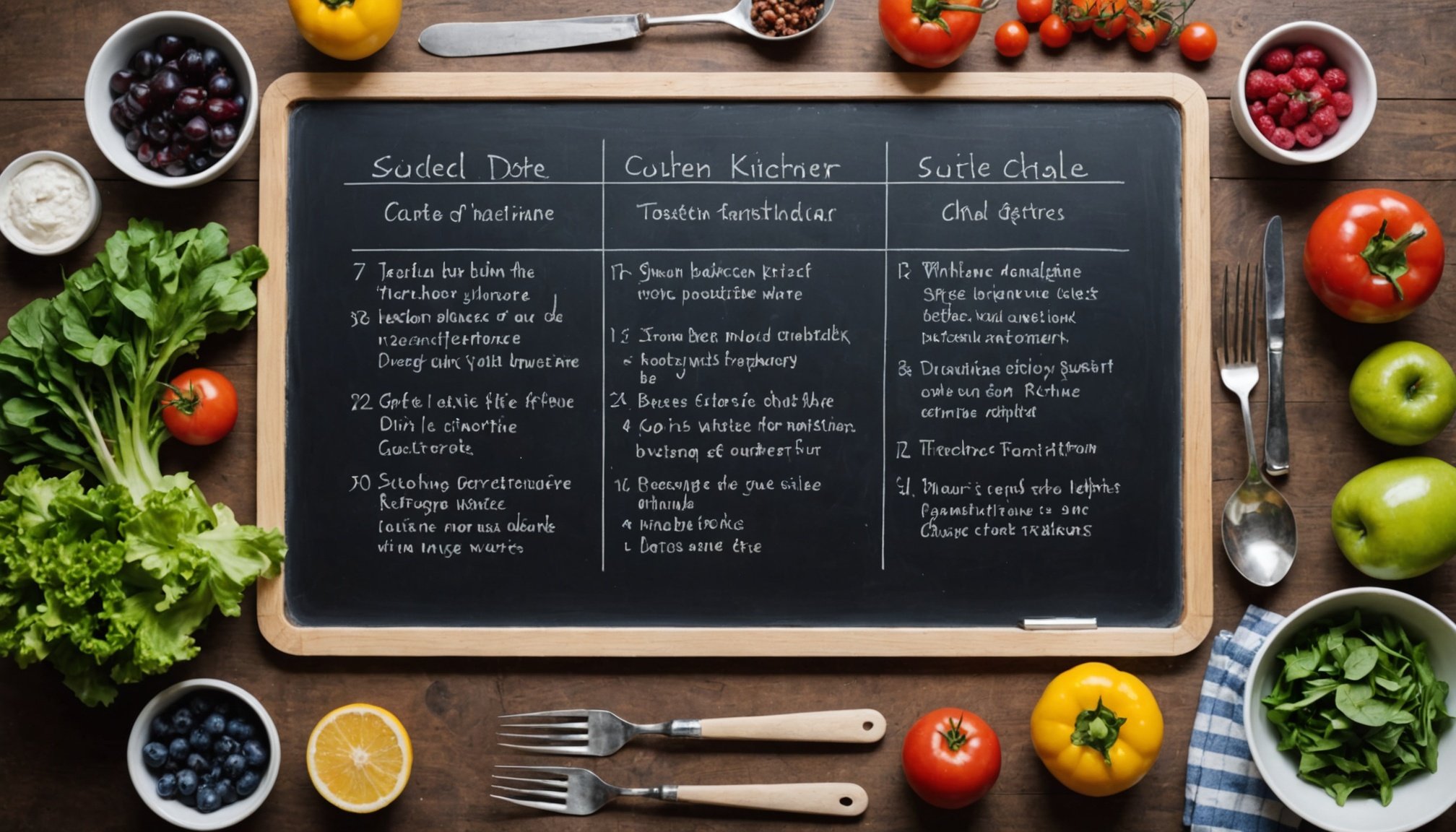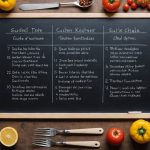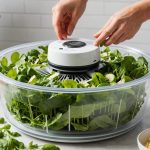A kitchen chalkboard may seem like a simple addition to your home, but it can revolutionize the way you track your diet. Visual reminders enhance motivation and keep your goals front and center.
Whether you're jotting down daily meals or tracking nutritional goals, this versatile tool can cater to your unique needs. Explore how a chalkboard can turn chaotic meal planning into a streamlined and enjoyable experience while fostering healthier habits that stick.
This might interest you : Top Kitchen Ceiling Materials for Enhanced Cleanliness and Health: A Comprehensive Guide
Benefits of Using a Kitchen Chalkboard for Diet Tracking
A kitchen chalkboard can be a game-changer for those committed to maintaining a healthy lifestyle. One of the primary benefits is the enhanced visibility of meal plans. By having your weekly meals prominently displayed, you can easily keep track of what you plan to eat, which helps in making informed dietary choices. This visual reminder can be especially useful in busy households where meal planning might otherwise fall by the wayside.
Moreover, a kitchen chalkboard encourages accountability and consistency in diet tracking. When meals are planned and written down, it becomes easier to stick to your dietary goals. This consistency is key to developing healthier eating habits over time. The act of physically writing down your meals can also reinforce your commitment to a balanced diet.
Also read : Unlock Healthier Eating: The Impact of Clear Fridge Doors on Dietary Choices in Your Home
Additionally, using a chalkboard can foster creativity in meal preparation. With the flexibility to easily erase and rewrite, you can experiment with different meal ideas and ingredients without any hassle. This not only makes meal planning more enjoyable but also introduces variety into your diet, which can prevent the monotony of eating the same foods repeatedly. Embrace the advantages of a kitchen chalkboard and transform your diet tracking experience.
Setting Up Your Kitchen Chalkboard
Setting up a kitchen chalkboard effectively is crucial for maximizing its benefits. A well-organized chalkboard setup not only aids in organizing meal planning but also enhances the overall kitchen aesthetic.
Choosing the Right Chalkboard
Selecting the appropriate chalkboard is the first step. Consider the size based on your kitchen space and the amount of information you plan to display. A larger chalkboard might be ideal for bigger families, while a smaller one could suffice for singles or couples. Opt for a chalkboard with a smooth surface to ensure easy writing and erasing, which is essential for frequent updates.
Ideal Location for Your Chalkboard
Placement is key for visibility and convenience. Your chalkboard should be in a spot that's easily accessible and visible to all family members. Consider placing it near the kitchen entrance or adjacent to the refrigerator. This ensures that meal plans are noticed and referred to regularly, reinforcing the habit of meal planning.
Essential Tools and Supplies
To make the most of your chalkboard, gather essential tools such as high-quality chalk or chalk markers for vibrant and clear writing. A soft cloth or eraser is necessary for easy updates. Additionally, consider using small magnets or clips if your chalkboard is magnetic, allowing you to attach recipes or notes directly.
Creative Ways to Use Your Chalkboard
A kitchen chalkboard is a versatile tool that extends beyond basic meal planning. By adopting creative meal tracking methods, you can transform your dietary routine into an engaging experience. One innovative chalkboard idea is to design weekly meal menus. By visually laying out your meals for the week, you can easily identify patterns and make adjustments to ensure a balanced diet. This approach not only simplifies meal preparation but also helps in maintaining dietary variety.
Grocery List Management on Chalkboard
Incorporating a section for grocery list management on your chalkboard can streamline your shopping process. By jotting down items as they run out, you ensure nothing is forgotten during your next grocery trip. This method also allows for quick updates and makes it easy to manage your pantry inventory.
Visual Tracking of Daily Caloric Intake
Another creative use is the visual tracking of daily caloric intake. By noting down your daily calorie consumption, you gain a clearer understanding of your eating habits. This visual representation can help identify areas for improvement and promote mindful eating. Such innovative chalkboard ideas can make diet tracking an engaging and effective process.
Visual Examples of Chalkboard Meal Tracking
Incorporating chalkboard examples into your meal planning routine can enhance the visual meal tracking experience and make it more engaging.
Illustrated Meal Plans
Illustrated meal plans on a chalkboard can serve as a creative and effective tool for visual meal tracking. By drawing simple icons or sketches representing each meal, you can quickly grasp the week's menu at a glance. This not only adds a fun element to meal planning but also helps in identifying nutritional gaps or repetitive patterns in your diet. Such visual cues can be particularly beneficial for children, making them more interested in healthy eating habits.
Grocery List Layouts
Organising your grocery list on a chalkboard can streamline your shopping routine. By categorising items into sections such as produce, dairy, and pantry staples, you create a clear and organised list. This method reduces the chances of forgetting essential items and ensures a more efficient shopping experience. Additionally, having a dedicated space for grocery list layouts allows for easy updates as items run out.
Caloric Intake Charts
Creating caloric intake charts on your chalkboard provides a visual representation of your daily consumption. By plotting your calorie intake, you can easily monitor and adjust your eating habits to align with your dietary goals. This visual approach encourages mindful eating and helps in maintaining a balanced diet.
Tips for Organizing Your Chalkboard
A well-organized chalkboard can significantly enhance effective meal tracking. By implementing strategic chalkboard organization tips, you can streamline your diet planning and make it more efficient.
Color Coding for Different Food Categories
Using color coding is a practical method to differentiate between various food categories. Assign specific colors for proteins, vegetables, grains, and snacks. This not only makes your chalkboard visually appealing but also allows for quick identification of food groups, ensuring a balanced diet.
Sections for Meal Prep and Cooking Notes
Creating dedicated sections for meal prep and cooking notes can further optimize your chalkboard's functionality. Allocate space for listing ingredients needed for upcoming meals and jot down any special cooking instructions. This helps in organizing your cooking process and reduces the likelihood of missing key steps or ingredients.
Regular Updates and Maintenance Strategies
To maintain the effectiveness of your chalkboard, regular updates are essential. Erase and rewrite meal plans weekly to keep information current. Additionally, clean the chalkboard surface regularly to ensure clarity. This practice not only keeps your meal tracking accurate but also prolongs the life of your chalkboard.
Integrating Chalkboard into Your Daily Routine
Incorporating a kitchen chalkboard into your daily routine can revolutionise your approach to daily diet tracking. By seamlessly integrating it into your lifestyle, you can maintain a consistent and effective dietary regimen.
Morning Meal Prep Rituals
Start your day with a structured morning meal prep ritual. Use the chalkboard to outline your breakfast and lunch plans, ensuring you stick to your dietary goals. This proactive approach helps in organising your meals and reduces the temptation of unhealthy snacking throughout the day.
Evening Reviews of Daily Intake
Conclude your day with evening reviews of daily intake. Reflect on your meals by noting down what you consumed. This practice not only aids in accountability but also highlights areas where you may need to make healthier choices. Regular review ensures that you remain aligned with your dietary objectives.
Weekly Reflection and Adjustments
At the end of each week, dedicate time for weekly reflection and adjustments. Evaluate your meal choices and identify patterns that require change. Use this insight to adjust your upcoming week's meal plan on the chalkboard, fostering continuous improvement in your dietary habits. This routine integration promotes sustainable and mindful eating practices.
Overcoming Challenges with Chalkboard Tracking
Using a kitchen chalkboard for diet tracking is beneficial, but it comes with its own set of challenges. One common issue is maintaining consistency in updates. Regularly revisiting and revising your meal plans ensures that the information stays relevant and useful. This practice helps in aligning your dietary tracking with your current goals.
Another challenge is dealing with chalkboard clutter. Over time, the board can become crowded with information, making it less effective. To combat this, ensure you regularly clean and organise the board. Allocate specific sections for different types of information, like meal plans, grocery lists, and notes, to maintain clarity and order.
Adjusting for dietary changes and preferences is also crucial. As your dietary needs evolve, your chalkboard should reflect these changes. This might include updating meal plans to incorporate new dietary preferences or restrictions. Being adaptable and flexible with your chalkboard solutions is key to overcoming these challenges and ensuring your diet tracking remains effective and aligned with your lifestyle. By addressing these challenges head-on, you can maximise the benefits of using a kitchen chalkboard for diet tracking.
Success Stories: Users Share Their Experiences
Exploring diet success stories can provide inspiration and motivation for those seeking to enhance their dietary habits. Many individuals have shared their chalkboard testimonials, highlighting the positive impact this tool has had on their journey.
Transformational Journeys with Chalkboards
Numerous users report significant lifestyle changes thanks to their kitchen chalkboards. For instance, one user described how visual meal tracking helped them reduce impulsive eating and stick to their nutritional goals. Another shared that the chalkboard fostered family involvement in meal planning, making it a collaborative effort. These stories underscore the chalkboard's role in transforming dietary routines.
Tips from Experienced Users
Experienced users recommend keeping the chalkboard in a high-traffic area to ensure constant visibility. They also suggest integrating it into daily routines, like reviewing it during meal prep. One tip is to use vibrant colours for different food groups, enhancing readability and engagement. These insights can guide new users in maximising their chalkboard's effectiveness.
Common Mistakes to Avoid
Avoid overcrowding the chalkboard with excessive information, as this can lead to confusion. Another common mistake is neglecting regular updates, which diminishes its usefulness. Users also advise against using low-quality chalk, which can hinder readability. Learning from these pitfalls can enhance your chalkboard experience.
Long-term Benefits of Consistent Tracking
Consistent tracking advantages extend beyond immediate dietary changes, offering substantial long-term diet benefits. By maintaining regular tracking, individuals can sustain healthy eating habits over time. This ongoing practice fosters a mindful approach to food choices, encouraging a balanced diet.
Tracking also builds awareness of food choices. By consistently noting meals and ingredients, individuals develop a deeper understanding of their dietary patterns. This awareness is crucial for making informed decisions, allowing for adjustments that align with nutritional goals. Over time, this can lead to improved health outcomes and a more conscious relationship with food.
Moreover, consistent tracking enhances overall meal satisfaction. By planning and reflecting on meals, individuals can identify which foods provide the most enjoyment and nourishment. This insight allows for the creation of meals that are both satisfying and nutritious, reducing the likelihood of unhealthy snacking or impulsive eating.
In summary, the long-term diet benefits of consistent tracking are profound. By sustaining healthy habits, building food awareness, and enhancing meal satisfaction, individuals can achieve lasting improvements in their dietary routines. This practice not only supports physical health but also contributes to a more fulfilling and enjoyable eating experience.











